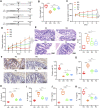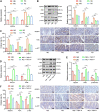Resveratrol Alleviates Dextran Sulfate Sodium-Induced Acute Ulcerative Colitis in Mice by Mediating PI3K/Akt/VEGFA Pathway
- PMID: 34497510
- PMCID: PMC8419259
- DOI: 10.3389/fphar.2021.693982
Resveratrol Alleviates Dextran Sulfate Sodium-Induced Acute Ulcerative Colitis in Mice by Mediating PI3K/Akt/VEGFA Pathway
Erratum in
-
Erratum: Resveratrol Alleviates Dextran Sulfate Sodium-Induced Acute Ulcerative Colitis in Mice by Mediating PI3K/Akt/ VEGFA Pathway.Front Pharmacol. 2021 Nov 2;12:797101. doi: 10.3389/fphar.2021.797101. eCollection 2021. Front Pharmacol. 2021. PMID: 34795595 Free PMC article.
Abstract
Ulcerative colitis (UC) is a chronic inflammatory disease that affects the colon, and its incidence is on the rise worldwide. Resveratrol (RSV), a polyphenolic compound, was recently indicated to exert anti-inflammatory effects on UC. Consequently, the current study was conducted to investigate the mechanism of RSV on alleviating UC in mice by mediating intestinal microflora homeostasis. First, potential targets that RSV may regulate UC were screened using the TCMSP database. Next, mice were treated differently, specifically subjected to sham-operation and dextran sulfate sodium (DSS) induction, and then treated or untreated with RSV. Disease Activity Index (DAI) and Hematoxylin-Eosin (HE) staining were employed to analyze the pathological changes of mice colon. In addition, the expression patterns of inflammatory factors in spleen tissues were detected using ELISA, while the protein expression patterns of phosphoinositide 3-kinase (PI3K), protein kinase B (Akt), and vascular endothelial growth factor A (VEGFA) in colon tissues were determined by means of immunohistochemistry (IHC) and Western blot analysis. Moreover, changes in intestinal flora and metabolite diversity in UC were analyzed by metabonomics. It was found that RSV played inhibitory roles in the PI3K/Akt pathway in mice. Meanwhile, the administration of RSV induced downregulated the expressions of TNF-α, IFN-γ, IL-1β, IL-6, and IL-4. The six floras of Haemophilus and Veillonella were significantly enriched in UC, while Clostridium, Roseburia, Akkermansia, and Parabacteroides were found to be enriched in control samples. Lastly, it was noted that Akkermansia could regulate the intestinal flora structure of UC mice through triacylglycerol biosynthesis, glycerol phosphate shuttle, cardiolipin biosynthesis, and other metabolic pathways to improve UC in mice. Altogether, our findings indicate that RSV suppressed the activation of the PI3K/Akt pathway and reduced the VEGFA gene expression to alleviate UC in mice.
Keywords: phosphoinositide 3-kinase; protein kinase B; resveratrol; ulcerative colitis; vascular endothelial growth factor A.
Copyright © 2021 Zhu, Zheng, Xu, Xi, Chen and Xu.
Conflict of interest statement
The authors declare that the research was conducted in the absence of any commercial or financial relationships that could be construed as a potential conflict of interest.
Figures






Similar articles
-
Baitouweng decoction alleviates dextran sulfate sodium-induced ulcerative colitis by regulating intestinal microbiota and the IL-6/STAT3 signaling pathway.J Ethnopharmacol. 2021 Jan 30;265:113357. doi: 10.1016/j.jep.2020.113357. Epub 2020 Sep 3. J Ethnopharmacol. 2021. PMID: 32891820
-
Resveratrol alleviates intestinal mucosal barrier dysfunction in dextran sulfate sodium-induced colitis mice by enhancing autophagy.World J Gastroenterol. 2020 Sep 7;26(33):4945-4959. doi: 10.3748/wjg.v26.i33.4945. World J Gastroenterol. 2020. PMID: 32952341 Free PMC article.
-
Anti-inflammatory effects of Brucea javanica oil emulsion by suppressing NF-κB activation on dextran sulfate sodium-induced ulcerative colitis in mice.J Ethnopharmacol. 2017 Feb 23;198:389-398. doi: 10.1016/j.jep.2017.01.042. Epub 2017 Jan 22. J Ethnopharmacol. 2017. PMID: 28119098
-
Astragaloside II alleviates the symptoms of experimental ulcerative colitis in vitro and in vivo.Am J Transl Res. 2019 Nov 15;11(11):7074-7083. eCollection 2019. Am J Transl Res. 2019. PMID: 31814910 Free PMC article.
-
Canna x generalis L.H. Bailey rhizome extract ameliorates dextran sulfate sodium-induced colitis via modulating intestinal mucosal dysfunction, oxidative stress, inflammation, and TLR4/ NF-ҡB and NLRP3 inflammasome pathways.J Ethnopharmacol. 2021 Apr 6;269:113670. doi: 10.1016/j.jep.2020.113670. Epub 2020 Dec 8. J Ethnopharmacol. 2021. PMID: 33301917
Cited by
-
Exploring the Mechanisms of Self-made Kuiyu Pingchang Recipe for the Treatment of Ulcerative Colitis and Irritable Bowel Syndrome using a Network Pharmacology-based Approach and Molecular Docking.Curr Comput Aided Drug Des. 2024;20(5):534-550. doi: 10.2174/1573409919666230515103224. Curr Comput Aided Drug Des. 2024. PMID: 37190808
-
Harnessing the Anti-Inflammatory Properties of Polyphenols in the Treatment of Inflammatory Bowel Disease.Int J Biol Sci. 2024 Oct 14;20(14):5608-5672. doi: 10.7150/ijbs.98107. eCollection 2024. Int J Biol Sci. 2024. PMID: 39494333 Free PMC article. Review.
-
Evaluation of Lacticaseibacillus casei 39 Paraprobiotic in Modulating Inflammatory and Oxidative Pathways in Acetic Acid Induced Ulcerative Colitis.Food Sci Nutr. 2025 Jul 18;13(7):e70476. doi: 10.1002/fsn3.70476. eCollection 2025 Jul. Food Sci Nutr. 2025. PMID: 40688608 Free PMC article.
-
Nrf2-mediated ferroptosis inhibition: a novel approach for managing inflammatory diseases.Inflammopharmacology. 2024 Oct;32(5):2961-2986. doi: 10.1007/s10787-024-01519-7. Epub 2024 Aug 10. Inflammopharmacology. 2024. PMID: 39126567 Review.
-
Resveratrol for inflammatory bowel disease in preclinical studies: a systematic review and meta-analysis.Front Pharmacol. 2024 Jun 14;15:1411566. doi: 10.3389/fphar.2024.1411566. eCollection 2024. Front Pharmacol. 2024. PMID: 38948464 Free PMC article.
References
LinkOut - more resources
Full Text Sources

